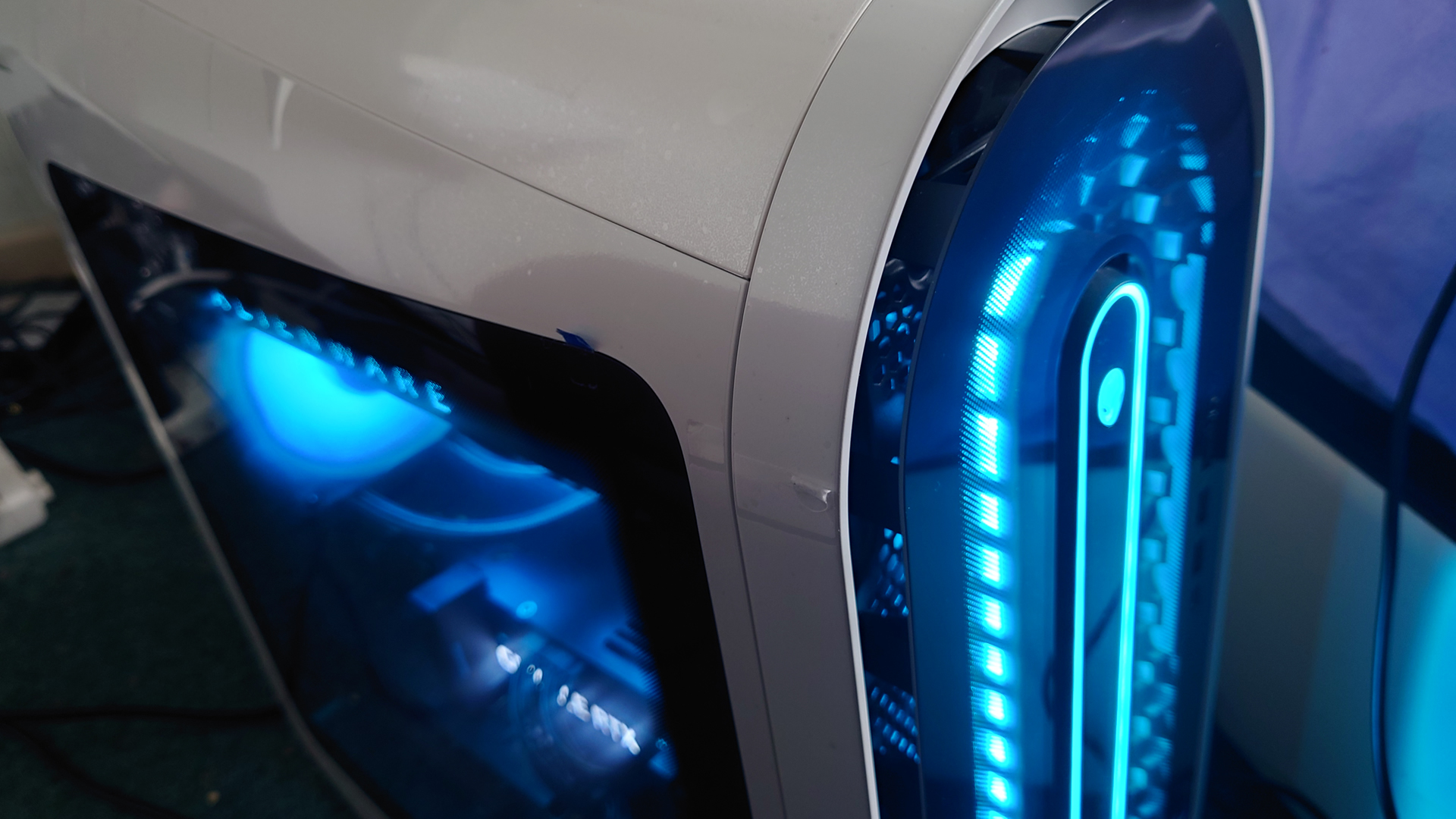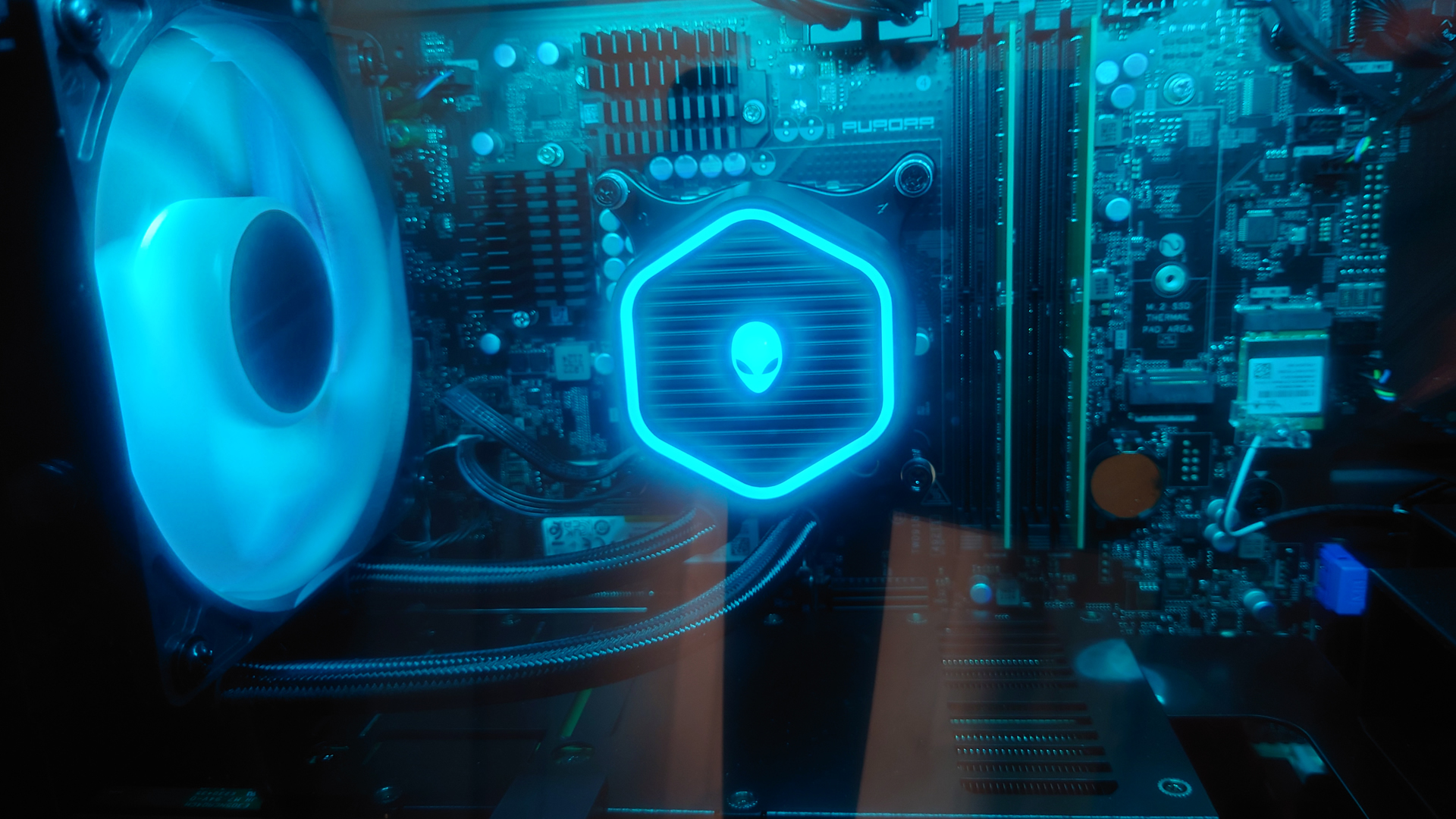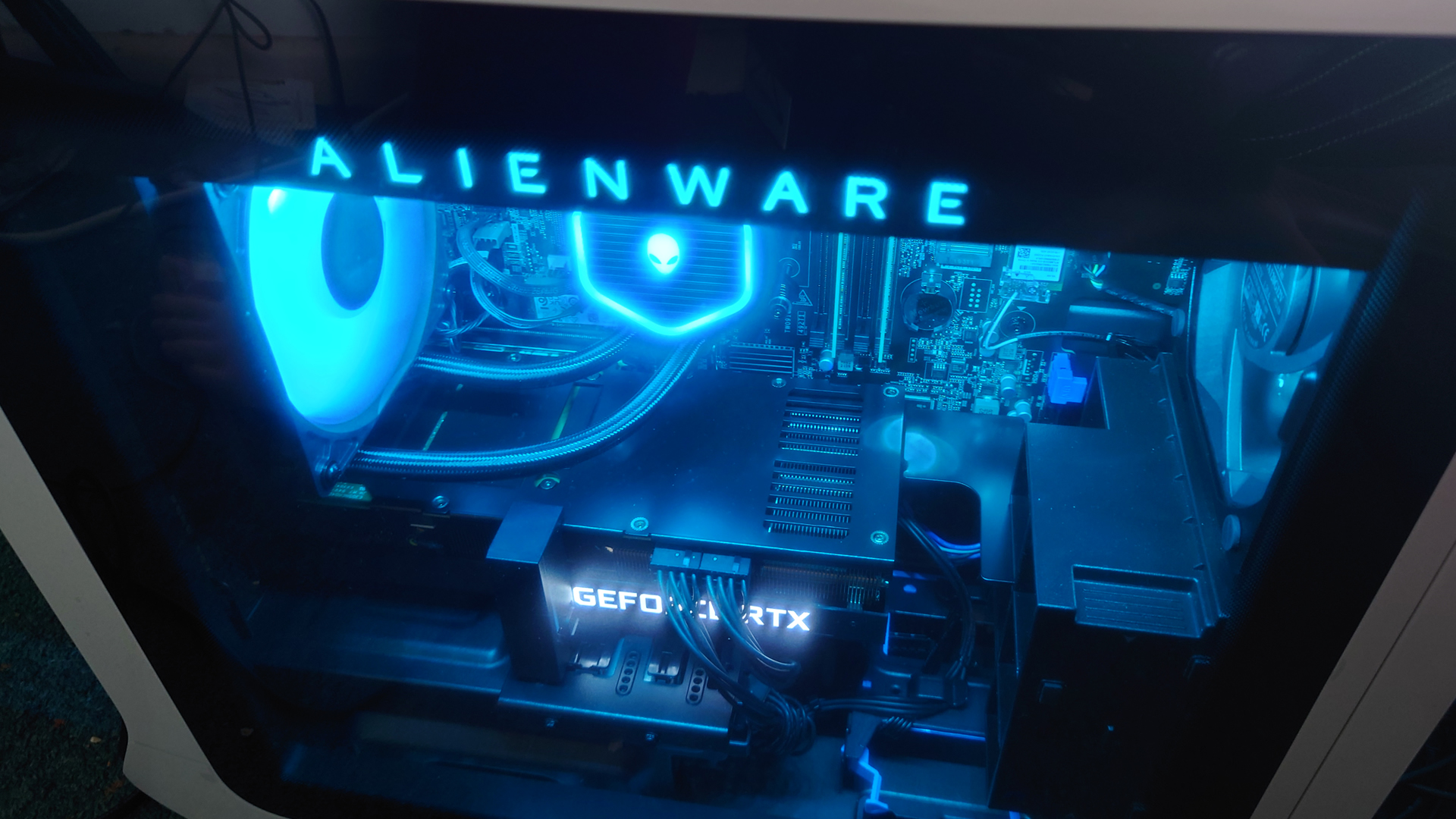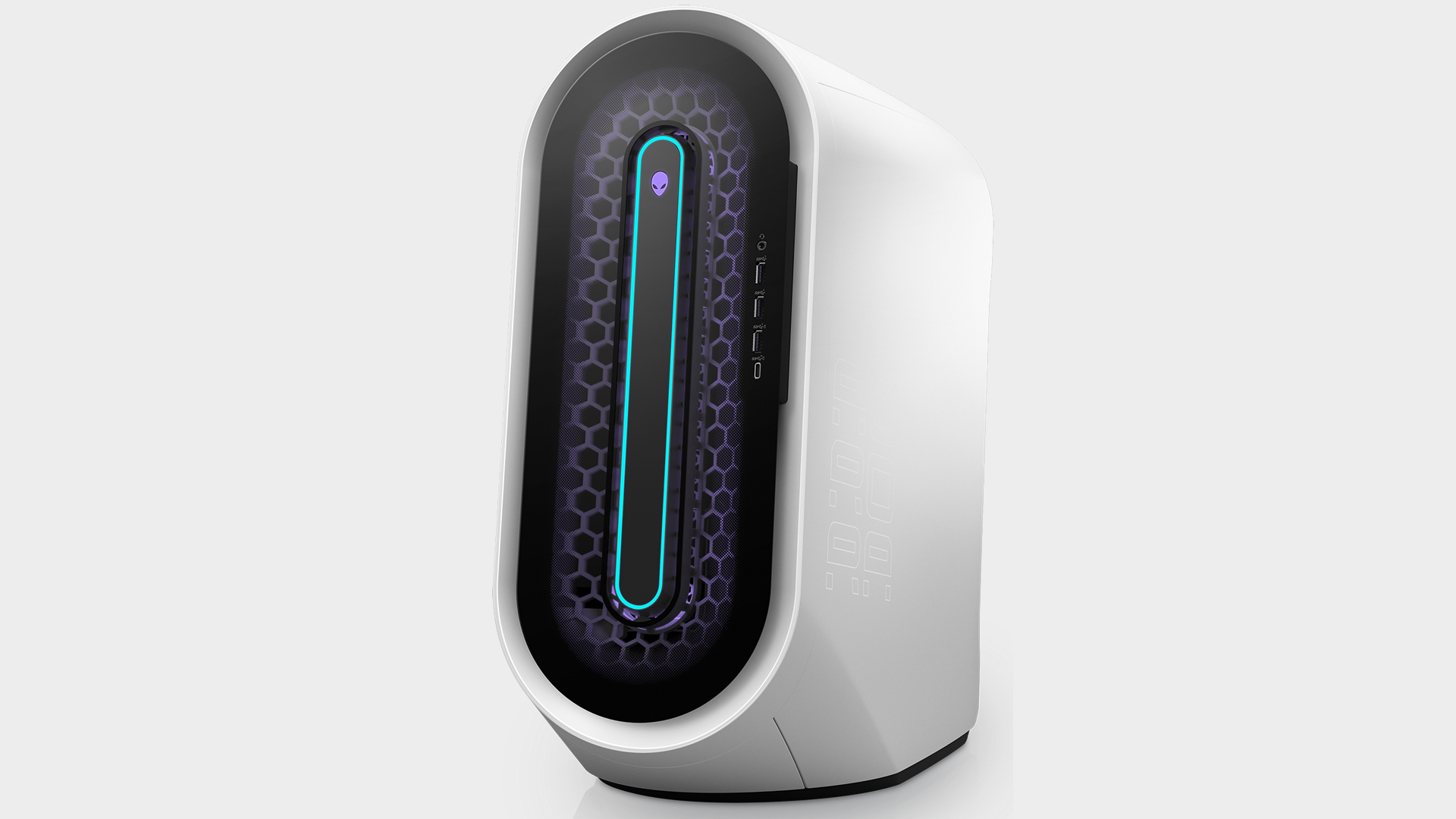GamesRadar+ Verdict
The Alienware Aurora R13 is easily the best PC that the long-running brand has produced so far, with cleverly redesigned visuals and stellar hardware. However, this latest model is every bit as loud and hot as the predecessors, too.
Pros
- +
Support for DDR5 / PCIe 5.0
- +
Excellent 4K performance
- +
Effectively futureproofed
Cons
- -
Love it or hate it design
- -
The brand's premium price tag
- -
Gets loud and hot quite quickly
Why you can trust GamesRadar+
The Alienware Aurora R13 is the brand's latest in a long line of Intel-led machines, and in my opinion it also happens to be one of the best gaming PCs that you can get your hands on this year. Featuring the latest Intel Core 12th gen Alder Lake processors, you've got the unrivaled bandwidth of PCIe 5.0 and DDR5 support inside, so it's a rig that's ready for the future of gaming.
This is not a cheap gaming PC. With a $3,500 MSRP, you're paying a considerable premium on all that power. However, the performance on display really does speak for itself, and there's seldom an easier option for those wanting ray traced 4K60 this year, with few compromises to speak of.
Design and Features
Here's what's inside our Alienware Aurora R13 review unit that was supplied to GamesRadar.
Processor: Intel Core i9-12900KF
GPU: Nvidia RTX 3080
Memory: SK-hynix HMCG88MEBUA081N 64GB DDR5
Storage: Samsung PM9A1 NVMe 1TB
3.5mm; (2x) USB 3.2 Gen 1 ports, (1x) USB 3.2 Gen (PD), (1x) USB-C (front I/O); HDMI 2.1 (x1: DisplayPort 1.4 (x3); (2x) 3.5mm, USB-C (x2); USB 2.0 (4x); (2x) USB 3.2, RJ-45 Killer E3100 Gigabit Ethernet, Line in, Subwoofer output, SPDIF digital out.
Dimensions (H x W x D): 20.1 x 8.86 x 20.8 inches
Weight: 34.2lbs / 15.5kg
The Alienware Aurora R13 is quite the substantial jump from the tried-and-true visual aesthetics of the previous Intel-lead Aurora machine. This new version's most prominent additions include a clear window on the left-hand side which allow you to look into the internals of the unit itself. There's a custom-developed pump and radiator AIO water cooler, with the Alien head logo itself over where the CPU is housed. It's a small touch, sure, but there's certainly something to be said for the transparency on offer with having your hardware visible in this way.
I think it's fair to say that Alienware gaming PCs have always had a love it or hate it design philosophy; you either like the rounded edges and glossy plastic chassis or you don't. I'll be entirely honest, I am not a huge fan of the look of this machine, but I do enjoy the new changes made to its visual language this time around and that's certainly a step in the right direction. Considering the premium paid on rigs like this, having an all-plastic chassis doesn't exactly scream luxury, though looks are entirely subjective.

What I can praise in the Alienware Aurora R13's design is the RGB lighting. The re-tooled front pacing panel allows for a bright and vivid LED display, which can be custom-tweaked in proprietary software giving you all manner of color combinations for both the newly-visible components inside and the face of the machine. It's a really nice touch, and is sure to add an aura of personality to one's personal setup in a way that few manufacturer-made machines have been able to rival.
Looks aside, easily the biggest advantage that the new Alienware Aurora R13 has over its older siblings is the adoption of PCIe 5.0 compatibility and DDR5 support through Intel's Alder Lake Gen 12 processors. Our review unit came running the powerful Intel Core i9-12900KF, with SK-hynix 64GB DDR5 RAM clocked at 4400MHz, and an RTX 3080. That's a pretty good combo, and while the gaming RAM and graphics card are far from the flagship status of the processor, they're still more-than-solid additions in a build like this.

Performance
Here's how the Alienware Aurora R13 review got on in some of our industry-standard benchmarking tests.
Firestrike (1080p): 35,563
Firestrike Extreme (1440p): 19,708
Firestrike Ultra (2160p): 10,565
Time Spy: 16,806
Time Spy Extreme: 8,437
Cinebench CPU: 1923 pts (single-core); 23,485 pts (multi-core)
CrystalDiskMark: 7,020 MB/s read; 5,221.86 MB/s write
PC Mark 10: 8,928
Opinions on how the Alienware Aurora R13 looks are all well and good, but it's in the performance that this gaming PC genuinely shines. Given how our review unit is spec'd out, you will be unsurprised to hear that you can generally expect maxed-out ray-traced 4K60 FPS in the vast majority of titles, and that's likely to be the sweet spot for a machine like this in 2022.
Our industry-standard tests proved little match for the rig as I clocked some respectable numbers in the likes of 3D Mark and PC Mark 10, which have only really been bettered by the Acer Predator Orion 7000 with a slightly more powerful configuration. Still, whether Time Spy (DirectX12 testing) or Firestrike (DX11) in their various forms, the Alienware Aurora R13 excelled where it matters.
This is how the Alienware Aurora R13 got on running games in the RTX 3080's most preferred resolution:
Metro Exodus (PC Enhanced Edition):
Extreme settings; ray tracing maxed out: 65 FPS
High settings; ray tracing on: 80 FPS
Shadow of the Tomb Raider:
Highest settings: 115 FPS
High settings: 127 FPS
The Division 2:
Ultra settings: 60 FPS
High settings: 93 FPS
Red Dead Redemption 2:
Ultra settings: 66 FPS
High settings: 89 FPS
Total War: Three Kingdoms:
Ultra settings: 45 FPS
High settings: 65 FPS
DLSS set to 'Performance' mode here available.
All frame rates are averages taken in-game or through benchmarks
Particular attention can be given to the included Samsung PM9A1 NVMe drive, which, while lacking the name recognition of some of the brand's best SSDs for gaming, more than achieved its quoted Gen 4.0 speeds. CrystalDiskMark gave it a score of 7,020 MB/s read and 5,211.86 MB/s write, so that's more than fast enough to take advantage of DirectStorage API and push those HD textures in titles that support such technology.
Gaming on the Alienware Aurora R13 was a very pleasant experience, as our review unit had nothing to worry about whatsoever with our suite of benchmarking titles, nor the games that I used it for in my own time. As with any gaming PC that's capable of true 4K performance, everything in our roster was extensively tested in 1080p, 1440p, and 2160p and the results really do speak for themselves. If you've got your hands on one of the best 4K monitors for gaming, then the visual fidelity afforded by the Alienware Aurora R13 can certainly accommodate.
For the sake of parity, I ran the games that could support Nvidia DLSS in Performance mode in order to get a fair spread when pushing the ray tracing capabilities to the limits. 4K60 was the mean average in games such as Metro Exodus PC Enhanced Edition (set to RTX Extreme) with Red Dead Redemption II at its highest setting proving a similar benchmark figure.

This is how the Alienware Aurora R13 fared when running our benchmark games in other resolutions.
Metro Exodus (PC Enhanced Edition):
Extreme settings; ray tracing maxed out (1440p): 90 FPS
High settings; ray tracing on (1440p): 115 FPS
Extreme settings; ray tracing maxed out (1080p): 107 FPS
High settings; ray tracing on (1080p): 134 FPS
Shadow of the Tomb Raider:
Highest settings (1440p): 179 FPS
High settings (1440p): 192 FPS
Highest settings (1080p): 209 FPS
High settings (1080p): 217 FPS
The Division 2:
Ultra settings (1440p): 119 FPS
High settings (1440p): 154 FPS
Ultra settings (1080p): 159 FPS
High settings (1080p): 186 FPS
Red Dead Redemption 2:
Ultra settings (1440p): 98 FPS
High settings (1440p): 138 FPS
Ultra settings (1080p): 123 FPS
High settings (1080p): 161 FPS
Total War: Three Kingdoms:
Ultra settings (1440p): 179 FPS
High settings (1440p): 170 FPS
Ultra settings (1080p): 142 FPS
High settings (1080p): 201 FPS
DLSS set to 'Performance' mode where available.
All frame rates are averages taken in-game or through benchmarks
Even several years after their initial release, these are still graphically demanding and hardware-intensive titles, and the RTX 3080 inside keeps up with them well. The GPU's onboard 10GB GDDR6 VRAM isn't likely to be exceeded by too many games in the near future, so you have significant overhead to keep enjoying maximum visual fidelity with a rock-solid framerate. Even the best gaming monitors haven't widespread adopted 4K at higher frame rates, yet, so you should be covered in this respect, too.
For those gamers chasing a higher average FPS, you'll need to scale things back to 1440p. QHD has long since been the trade-off for that crucial balance between visuals and smoother gameplay, and the same can be said for the Alienware Aurora R13. The vast majority of the games in our test setup more than exceeded the 120 FPS+ range, whether set to High or Ultra settings, with 1080p numbers climbing over 200 FPS in some instances. This means that the Alienware Aurora R13 is ideal for Esports titles should you want to meet those 240Hz limits for zero latency.
That brings me to my one main criticism of the Alienware Aurora R13, and that's all down to the small AIO water cooler used. It's no secret that the i9-12900KF, for as great as a processor as it is, does run on the hotter side of things, and this machine definitely lets you know that. Even under the most mild of stress, be that in benchmarking or casual play sessions, the rig itself gets both incredibly loud and unsurprisingly warm. I didn't clock any dangerous temperatures in my testing, however, you can certainly tell the difference between a machine with a full-size radiator (240mm or 360mm) and those without.
Although you can alter your heat dissipation settings in the Alienware Command Center, I choose to let the machine itself regulate its own cooling. This was done to see how the software itself could keep the Alienware R13 chill without me having to intervene. The PC doesn't get deafeningly loud when in full throttle, though, the sounds are not what you want to be hearing for extended periods of time when the action on-screen gets heavy. This isn't necessarily a criticism of the Alienware rig itself, though, as the 12th i9 does run hot, I just think that better thermals could be achieved by giving the chassis a little more room to breathe and having more than just a 120mm AIO on such a behemoth of a processor.

Should you buy the Alienware Aurora R13?
The Alienware Aurora R13 is a great gaming PC, that much should be apparent, however, the brand does come with its own premium price tag to match. Our specific review unit configuration will cost you $3,500, and that's right at the top of the pricing spectrum for an RTX 3080 PC. It should be stated, however, that you're benefitting from not only the latest line of Intel Core processors here, but the futureproofing PCIe 5.0 compatibility inside, that other RTX 3080-enabled machines on the market right now are rarely matching.
Considering the performance of our review unit itself, as well as the wide spectrum of configuration options available directly from Dell itself, the Alienware Aurora R13 is one of the better investments you can make from a reliable manufacturer this year.
How we tested the Alienware Aurora R13
In my three-week period with the Alienware Aurora R13, I stress tested the gaming PC with our industry-standard benching software, such as Firestrike, Time Spy, PC Mark 10, and CDM, while also putting it through its paces in many demanding games.
The Alienware Aurora R13 replaced my usual gaming PC for both my working days and in my own time so I was able to fully test it up against my rig as PC gamers would actually use the device. This meant playing games that were available through the likes of Steam, Origin, Ubisoft Connect, GOG Galaxy, and the Epic Games Store for an encompassing overview of what this machine could do. In the interest of fairness, I also tested this PC when connected to not only my 4K gaming monitor but also a 1440p and 1080p panel, too.
You can read more about how we test gaming PCs in our full GamesRadar Hardware Policy, as well as how we decide verdicts on our reviews, too.
Gear up for the Alienware Aurora R13 with the best gaming keyboards, best gaming mouse, and best gaming desks.

Aleksha McLoughlin served as the Hardware Editor for GamesRadar from June 2021 until August 2022. Her main area of expertise was the PC gaming platform, which comprised buying guides, features, reviews, and news coverage on components and prebuilt machines. She was also responsible for gaming chairs and storage. She now works on a freelance basis while studying to become a university lecturer specializing in English for foreign territories. Prior to joining GamesRadar, she wrote for the likes of Expert Reviews, The Rory Peck Trust, No Clean Singing, Vinyl Chapters, and Tech Spark while also working with the BBC.




